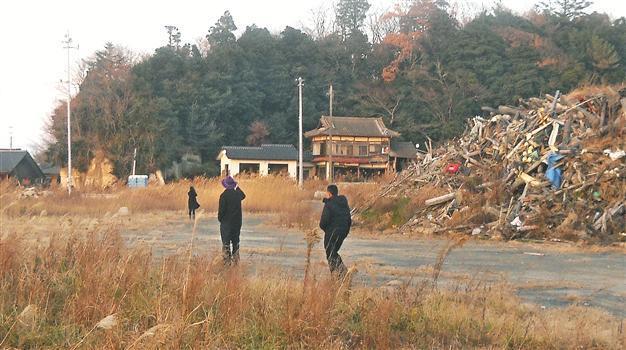Japan continues massive cleanup
FUKUSHIMA - Hürriyet Daily News

Officials walk around in Odaka, an abondoned Japanese town, approxiamately
15 kilometers away from the Fukushima’s Diachi-II nuclear plant. Hürriyet Daily News photo by Ali Kayalar
With piles of debris and car wrecks still cluttering the desolated tsunami-hit areas of a risky 15-kilometer radius around the Fukushima’s Diachi-II nuclear plant more than 18 months after the disaster, Japan is fighting multiple challenges, a new struggle for any country on earth.
The country’s decontamination efforts even include removing five centimeters of top soil in many places, checking every single sack of rice from the region and scrapping the bark from trees.
The Fukushima Agricultural Technology Center has been turned into a radiation-affected food detection facility, after being equipped with Germanium devices. Only 71 tests out of 9.44 million conducted on products there were returned as “positive” as of Nov. 12. Positive test results mean the levels registered above the health limits put into force by the Japanese authorities, which is below international standards.
This means that out of 12 million products that reach the center for testing some 79 percent are deemed suitable.
Public workers also mince meat into small pieces at the facility and carry out sensitive tests to confirm the meat’s health conditions, the Daily News observed during a one week visit to the region hosted by the Japanese Foreign Ministry.
However, the area’s river beds and forest areas still pose risks.
“It is very difficult to clean up the river beds and the deep water fish are risky as are some mushrooms,” Akihiro Sasaki, head of the agriculture center, told the Daily News.
Another center in Fukushima City, where the whole prefecture gets its name from, is an observatory run by scientists and volunteer locals. They record the decontamination in details, and offer transparent data to everyone. Problems with the forestry are also seen in their notes as cleaning is “in planning phase” in many forested areas.
The soil removed during the cleaning efforts is another challenge itself. Temporarily, it is deposited in soft bags and kept over a lead ground material and surrounded by non-radioactive soil. Still, locals are concerned about its final destination.
The decontamination is unthinkably rapid in Fukushima. Some 10 percent of the national income goes to the cleaning and rebuilding efforts, officials have said.
Japan today has a pro-nuclear government, with newly-elected Prime Minister Shinzo Abe promising to re-open closed nuclear facilities in three years.
Last week, only days after being sworn in, Abe visited the wreck of the Daichi II plant, where he said, “The massive work toward decontaminating is an unprecedented challenge in human history.”
Abandoned citiesBut many, like Minamisoma Mayor Katsunba Sakurai, believe the country may build itself a nuclear-free future.
Sakurai has reason to believe that many districts in his responsibility are still under radiation risk.
Take Odaka, a seaside town that saw a few kilometers of its shoreline destroyed by the recent tsunami that struck Japan. Much of Odaka’s inland infrastructure is almost totally desolated. Only a group of decontamination volunteers, some patrolling police and limited amount of firefighters, who keep an eye on people’s belongings, are seen on the cities empty streets.
The tsunami washed away 1,182 houses out of 3,771 in Odaka. The total number of houses destroyed in the disaster was officially recorded as 4,118. This cost more than 1,000 people.
A leading task for the government is to convince both citizens and the world that the country has progressed following the Fukushima disaster and particularly that the food is safe. Business groups there say that biased “irresponsible media reports” have badly hurt them.
Fukushima food is healthy and maybe even safer than any other place due to tight control, they pledged during a meeting where they offered local food to journalists.
There is no doubt that meat, rice and the traditional sake still retained its great taste.
But sales for tomato growers, sake firms, rice growers, dairies and many others have plummeted since the disaster.
Many countries increased controls over Japanese food. Turkey also started demanding a document from the Turkish Atom Energy Council (TAEK) last week when accepting imported food from Japan.
Hesitation about Fukushima food is not rare in the capital city of Tokyo.
The ministry’s visit program also included a ministerial level nuclear safety conference in Koriyama City which gathered representatives from over 100 countries along with global organizations, where transparency topped the agenda.
Yukiya Amano, the general director of the International Atom Energy Agency (IAEA) told the Daily News there that he expected the number of the nuclear facilities across the world to increase rapidly in the upcoming years despite the disaster in Japan.
The growing power need of the emerging economies will increase the demand, he said.
Japan has a lot of lessons to share with the world, especially with nations that are looking at building their first nuclear reactors such as Turkey, Lebanon and South Africa.
